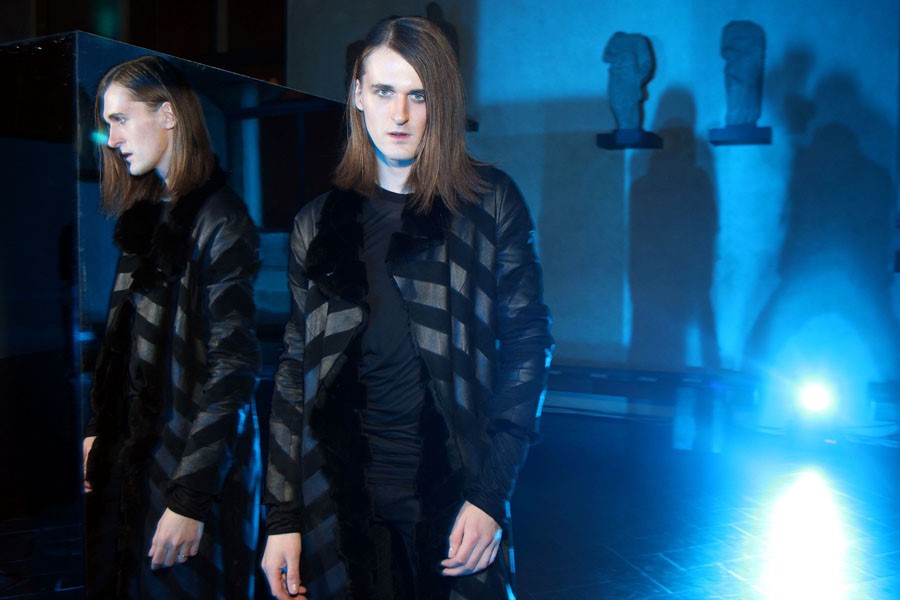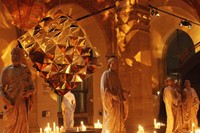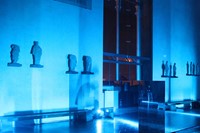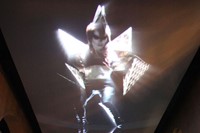Gareth Pugh has been challenging the conventions of the fashion system over the last couple of seasons. With his dark, gothic visions he has developed a signature style that blurs the traditional gender divide; women appear strong and powerful,
Gareth Pugh has been challenging the conventions of the fashion system over the last couple of seasons. With his dark, gothic visions he has developed a signature style that blurs the traditional gender divide; women appear strong and powerful, directing subversive men to their will. In some of the shows, the boys act as mere accessories, harnessed up like puppy dogs. But still, Mr Pugh confides that he really enjoys designing menswear, further explains how he is pushing the boundaries in the fashion film genre, and how the bespoke project at Pitti Uomo in January gave a preview to his upcoming show in Paris this week.
How much importance do you actually grant the menswear in your work?
Designing menswear comes quite naturally – my perfect male customer would be myself. But it is also important from a sales perspective. We are only selling during womenswear in Paris, but the menswear looks are doing really well there, so we decided to expand to menswear week. Still, I think the women’s is always going to be more important in what I do, because there are certain rules you can play with in menswear, but if you go too far it can easily look a bit drag. With women’s, there are no rules; they always are the peacocks of the show.
Do you like the gender play in fashion?
Yes, in my shows, the women are definitely the more dominant characters and the men the subservient figures. In my last catwalk show [S/S11] the women were supposed to be very powerful, aggressive almost, whereas the men were treated as accessories, like handbags. One guy had a harness of braces on his body, which was a tongue-in-cheek reference to the ones you use to walk little dogs in. When I was showing in London, men and women were always mixed. When I moved the show to Paris, we dropped the men and just showed women, because I was told that you spoil the illusion if you add men to a womenswear show. I think it actually adds an interesting friction, especially in my case when the women are quite masculine and the men quite feminine.
Is it crucial to focus on the human body in fashion films?
The body is the central focus for every fashion designer; it’s the source of the energy for the films. In the past designers have been relying very heavily on stills to communicate their ideas, but clothes are meant to be seen in movement. The use of film makes it possible to show looks in motion to a much higher degree than in a catwalk show. collection can be shown in a more interesting and purer way through a film, because you create a world, which you can’t realise in a traditional show. A catwalk works very much like a tennis match: amodel walks up and down, gets changed and comes back. In a film you can have them flying in the air, blow them up, fill them with air. It’s a completely different medium, which is still in its infancy. I think it is only the tip of the iceberg what we are seeing now. We are not saying it’s the future, but it is a proposal to show how things could be. It’s quite an exciting time to be part of. People think about fashion film in the mindset of traditional filmmaking, but the question of the narrative is the wrong one. There is no script for a fashion show and a fashion film does not need one either. All it needs are very strong ideas that can be communicated in a visually gripping way. A fashion film needs to convey the designer’s ideas, not necessarily to tell a story.
How do you find inspiration?
Working out ideas is almost like a cathartic exercise for me. It’s like a permanent search for perfection, which you will never achieve, but it keeps you going and makes you want to create more. Inspiration is not something tangible I can describe, it is more about a mood or a feeling, a very personal thing. I don’t necessarily think too much about what I do. I never find myself pouring over books in the library or going on research trips to find inspiration. It is more about what feels right to me at the time and I do it. It’s like being in a tunnel where you come out with something you never imagined, but there is a moment for it. That’s what fashion is about.
Can you tell us more about the site-specific project at Pitti Uomo?
The collection was made exclusively for the event at Pitti. It's not being transformed into a selling collection, which made it quite a liberating project to do. We wanted to feel that we are in Italy, so we went with the Orsanmichele location. To a certain extent, this was a tongue-in-cheek homage to Italy, to its history and artistic achievements, referencing the Sistine Chapel, the tradition of frescoed ceilings and trompe-l'œil painting. It’s like a beautiful theatre happening above the audience, almost like a gate to heaven. It would have been easy for us to do something gothic, but we really wanted to capture the Italian spirit, renaissance culture, brash gold, Cavalli, something quite spirited and flamboyant. The project at Pitti is also precursor to my next show in Paris. Let’s see what comes out of it…
Gareth Pugh shows his women's A/W11 collection in Paris on Wednesday 2 March.
Text by George Ghon



